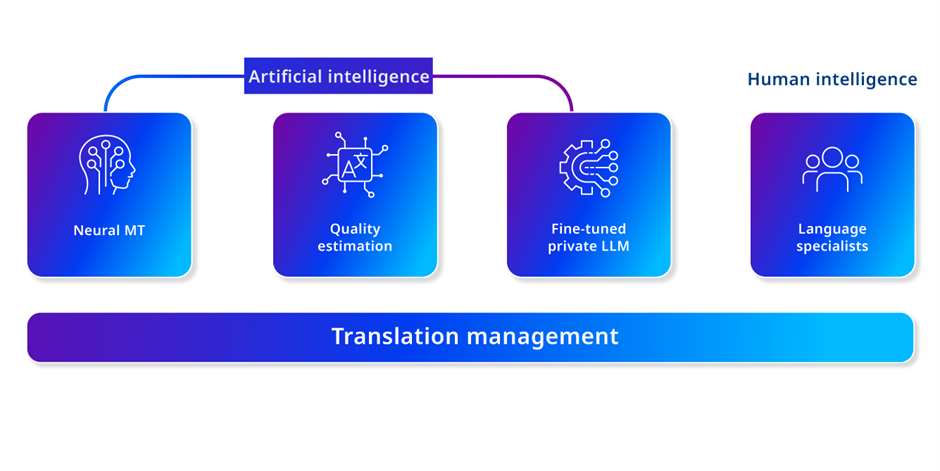Localization Evolved: The end of the localization bottleneck?
12 Dec 2024
 5 mins
5 mins

Those of us who’ve worked in the localization industry for many years know that change is constant – nothing stays the same for long.
Although the translation work itself remains strikingly familiar, the way the work gets done, and the tools now available to help translators do it, have changed beyond all recognition over time.
The use of translation memory, machine translation, and translation management tools to name but a few have transformed the localization industry and made it much more efficient. Companies can now translate much more content than they ever could before. And some of it, such as user reviews or knowledgebase articles, can be translated without any human involvement at all.
Despite these advances, as an industry, we’re still struggling to cope with the ever-expanding glut of content out there. The spectacular growth in demand from organizations for content in multiple languages, in multiple formats, to reach customers across multiple channels, is fast outstripping the localization industry’s capacity to meet that demand in a timely or cost-effective manner.
Companies want high-quality translations, quickly and cheaply, but find themselves bound by the iron triangle of quality, time and cost. You can have two of the three, but never all three at once. Something always has to give. You can have high-quality translated content at speed – but it will cost you. You can have content quickly and cheaply – but you will have to sacrifice quality.
Localization managers have long accepted these constraints – fully aware that they are expected to do more with less, expected to work miracles.
Technology has always come to our aid, but every time our industry has created new features to increase efficiency, the volume of content needing translation has simply eclipsed those efficiencies.
But what if technology can help us overcome these restraints? What if the latest developments in AI and large language models (LLMs) can get us to a place where we can break the iron triangle and get high-quality translations quickly and cheaply?
Redefining what’s possible
Everywhere you look, AI solutions are transforming business. GenAI offers us a golden opportunity to make revolutionary changes to the way we do things in the localization industry.
We have the potential to redefine what is possible. To radically change existing processes and production and make them massively more efficient.
If a competitor can almost overnight become 20 to 30% more efficient then they suddenly have a serious advantage over you. It’s no wonder the fear of missing out and falling behind is palpable and driving so much frenetic activity around AI.
Figuring out where best to use these transformative tools isn’t easy. It takes time to work out where it will add the most value. What is certain is that over the next few years companies will do exactly that – and those who fail to engage with AI, or fail to embed it into their localization processes, will struggle to compete.
Doing what we’ve always done is no longer an option – we must embrace the latest advances in technology. It’s just a matter of finding where AI can help improve localization processes or make the actual translation work more efficient.
The holy grail for companies is being able to translate any content, in any language, quickly and cost-effectively, without sacrificing quality – to break the iron triangle. If we can develop AI tools and LLMs that help us do that, the future of our industry is very bright indeed.
Human+AI
The biggest obstacle to breaking the iron triangle so far has been the human element.
There’s a limit to how many words a human translator can translate in a day – generally accepted to be around 3,000 words a day with a CAT tool. So if we want to meet this explosive demand for content and give clients what they want, translation technology has to be at the very heart of our solution. However, technology alone won’t solve every challenge – it may be faster and more economical, but it can’t guarantee the accuracy companies need for their content.
A blended approach is required that makes the best use of respective strengths – the speed of machines and the accuracy of humans. Luckily this already exists, is tried and tested, and is in widespread use – it’s called machine translation post-editing (MTPE).

However, even with the use of machine translation, MTPE and other translation technologies, there remains a significant chunk of the process that still requires human input – which inevitably slows things down. If we can use technology to increase the share of the process done by machines and reduce the amount of time spent by humans ensuring accuracy, then we’ve got a winning combination.
LLMs have a critical role to play in delivering better translation. Until recently they were virtually unheard of outside of the tech and localization industries, but have become a hot topic over the last year as they underpin the buzzworthy generative AI tools, such as ChatGPT, that everyone has been talking about. Their strength lies in producing natural-sounding text that feels like it’s been written by a human rather than a machine. As such, they have a key role to play in helping to produce higher quality fluency for translations that feel more human and less machine-like – and that can be produced much faster and more cost-effectively than with current processes. They enable greater automation and therefore less human involvement.
And if this solution can self-learn, so the more you use it, the better it applies your preferences, terminology and brand messages, then we are getting much closer to being able to break the iron triangle.
Any such solution would deliver significant efficiency gains for companies. It would also benefit from economies of scale – the more widely it is deployed across an organization, and the more it is used, the better it becomes and the bigger the efficiency gains it could achieve for the organization on an ongoing basis. And for localization professionals, use of such a solution may open up a more strategic role. If they become central to delivering significant efficiency gains, then they become much more critical and valuable to the business.
The future is here
For any solution to work in the real world right now, there has to be a blend of human intelligence with artificial intelligence if we are to get the best of both worlds and break the iron triangle.
Technology is already used extensively in the localization process – from managing projects and workflows, to using machine translation and translation memories – but it can’t do everything. Humans still have to be in the loop to ensure translation quality and make sure the translations are accurate.
This hybrid approach, the best of human and machine, is something we have been doing at RWS for some time now.
We have one of the largest networks of linguists in the world, with over 40,000 in-house and freelance translators working for us – an enormous source of human intelligence to draw upon. From our roots in scientific research at the University of Southern California way back in 2002, we now have over 20 years' experience of pioneering developments in artificial intelligence and 47 AI-related patents to prove it. We know what we’re doing and have been delivering real-world results using AI for decades.
Our revolutionary Evolve solution uniquely combines the capabilities of neural machine translation, large language models and human-in-the loop services, streamlined within a translation management system, to give customers a fully secure, end-to-end linguistic AI solution.
So what does that look like in detail?
The customer’s content is first submitted to our own translation management system, Trados Enterprise, so everything is kept within an end-to-end solution, which means everything can be tracked, monitored, and kept secure.
The automated workflow then processes the content through our neural machine translation platform, Language Weaver. No one has achieved perfect machine translation output yet, so the content is then analyzed by Machine Translation Quality Estimation (MTQE), also from Language Weaver, but specially trained by our own in-house language specialists. Unlike other Quality Estimation tools, our process leverages human intelligence to determine whether MT results are good, adequate but could be better, or poor, based on real-world post-editing scenarios.
The next step is new, and we believe will radically transform the efficiency of the translation process. The content that was assessed as being good is left alone and the content that’s adequate or poor goes through a fine-tuned LLM. The workflow repeats this process a maximum of three times if needed. With each iteration, more and more of the content is deemed good, and the amount that is deemed adequate or poor is reduced or eliminated. So, for example, instead of perhaps 30% of the content needing to be reviewed by our translators, by using this approach, the amount to review drops to say 10% – speeding up the process significantly and reducing costs.
By automating more of the post-editing step, we can minimize the amount of manual work needed and optimize our expert human translator workflows. As a result, Evolve delivers substantial efficiency gains across the translation supply chain – up to 65% – and radically transforms localization ROI.
What’s more, the suggested changes that are accepted as being better are then fed back into our neural machine translation, driving further improvements in the quality of our original output. Essentially, the more you use Evolve, the more it learns, and the better it gets. When adopted across an entire organization, Evolve accelerates and maximizes those efficiency gains, and therefore the strategic value of localization for global companies.
Evolve, our AI-powered translation solution, shatters the iron triangle so that companies can finally get what they’ve always wanted – high-quality translations, quickly and cost-effectively.
If you want to find out more about this new era of localization visit our Localization Evolved page, where you can take a quiz to discover where you are on the localization roadmap.
